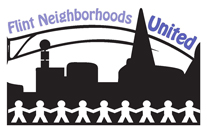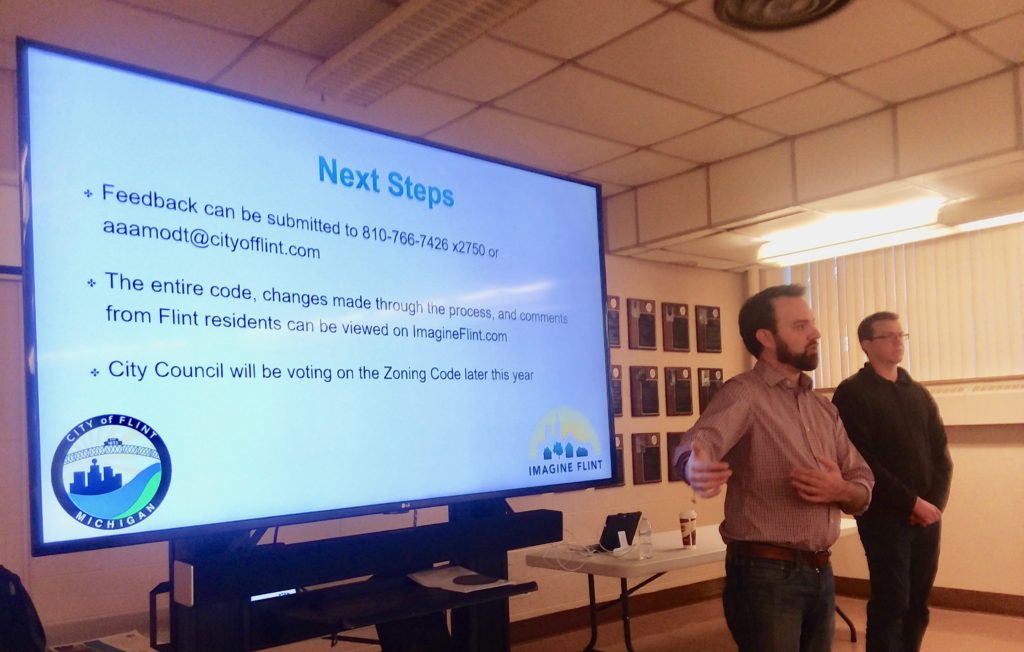By Luther Houle
“You guys are definitely the heroes. You don’t get paid for this,” said Glenn Wilson Saturday morning Oct. 5 at the Flint Public Library. “A breakfast is just something to say thank you to you guys, and keep up the hard work!”
Wilson, president of Communities First, Inc., a non-profit community development corporation, provided the Flint Neighborhoods United (FNU) monthly meeting with a full breakfast buffet.
Wilson recently cut the ribbon to the Coolidge Park Apartments, formerly Coolidge Elementary which he attended as a child.
His company also rehabilitated the former Oak School into a senior living complex and the Swayze Apartments for low-income and special needs tenants. He recently has encountered stiff resistance from a group of Carriage Town residents opposing his proposed development of a 48-unit affordable housing complex at what is now called University Square.
 Other highlights from the monthly meeting of about 50 of Flint’s officials, neighborhood leaders and activists included information on applications for a “Moving Flint Forward” business grant due Oct. 18, and a 45-minute presentation on the City’s newly proposed zoning code expected to see city council consideration later this year.
Other highlights from the monthly meeting of about 50 of Flint’s officials, neighborhood leaders and activists included information on applications for a “Moving Flint Forward” business grant due Oct. 18, and a 45-minute presentation on the City’s newly proposed zoning code expected to see city council consideration later this year.
Moving Flint Forward Grant for small businesses: deadline Friday Oct.18
Lottie Ferguson, director of grants and development at Flint and Genesee Chamber of Commerce spoke at the meeting to introduce and explain some details about what she called “Moving Flint Forward 2.0”. She reminded the group of the first iteration of the grant which “helped small businesses get the funds necessary to stay in business at the height of the water crisis.” She then explained that version 2.0 will help small businesses and neighborhoods at the same time through service projects.
The grant offers $10,000 to small businesses that meet a list of requirements. Business also have to perform a service project for one of Flint’s neighborhoods. Ferguson says, “It’s not a loan. We’re not asking small businesses to pay the money back. It could be used for improvements. It could be used for inventory. It could be used for upgrades or maintenance.”
The business must be at least one year old, have fewer than 20 employees, and be located inside the City of Flint. It also cannot be a franchise, or a nonprofit, and must be in good standing and not in bankruptcy. Businesses that have made it this far will be asked to complete a service project along with a nonprofit organization or neighborhood group of their choice.
Ferguson asked which groups could potentially use a service project. Carma Lewis, president of FNU, mentioned the Neighborhood Engagement Hub, the Crim Foundation, and Communities First, Inc.
Applications are due by 5 p.m. Friday, Oct. 18. Interested businesses can go to flintandgenesee.org/moving-flint-forward/ to find out if they qualify.
The Flint and Genesee Chamber of Commerce can be reached at (810)600-1404, or at the url above to answer questions about the grant, and receive ideas for potential service projects.

City of Flint Lead Planner Adam Moore and Zoning Coordinator Andy Aamodt describe proposed zoning code changes to the FNU (Photo by Luther Houle)
City official presents draft zoning code update
Adam Moore, lead planner for the Planning and Zoning Division of the City of Flint Department of Planning and Development, presented information about Draft Zoning Code Updates with the help of Andy Aamodt and Andy Fedewa.
Moore provided background details for why an updated zoning code is needed. According to Moore, nine years ago the City began to make its first master plan in 50 years.
He said it was a community-led master plan, steered by a committee of representatives from each ward, and paid for by a Challenge Grant from the Obama administration. Along with the master plan, Moore said the grant required a new capital improvement plan and a new zoning code.
According to Moore, the zoning code has been under development since 2015, when he began to work for the City of Flint. “We spent a couple years working with the steering committees to develop this code. It went to planning commission two and a half years ago. We had multiple public hearings, and 14 workshops ahead of that to make sure we got this code right.”
He added the feedback from those workshops and hearings, as well as responses from the staff, can be found online at imagineflint.com.
Now that the code has been approved by the planning commission and is ready to go before city council, Moore remarked that his presentation would be a final chance to answer questions before the zoning code goes before the city council for a first reading this month in its own special public city council meeting–date still to be determined.
Moore says “some of our city council meetings have been going quite late at night. we want to make sure this zoning code receives the attention that it needs, and that everyone is able to come.”
Moore said he expects the zoning code will go before council for a second reading in November, following a public hearing.
Details of the zoning code can be found at imagineflint.com/PlanImplementation/ZoningOrdinance.aspx.
Under the new code, all buildings are classified as permitted-by-right, special use, accessory use, additionally regulated use, or ground floor to determine what process is needed to approve their construction.
Each building’s classification is decided by its use and the zone in which it will reside. A zoning ordinance master use table can be found at the above URL.
Where a building is permitted is determined by its zoning district. The new code proposes 18 zoning districts in five different categories. These are residential, commercial, institutional, employment, or open spaces.
Residential zones
The residential zones include green neighborhoods, traditional neighborhoods, and mixed residential neighborhoods in varying densities. Moore began by explaining green neighborhoods, saying “the uses that are allowed in a traditional neighborhood versus a green neighborhood are almost exactly the same.”
He stated the main difference between the two is the size yard you are allowed. “You want to build a home in a green neighborhood, you do so on a larger lot.” Moore went on to describe traditional neighborhoods as single-family houses, and mixed residential neighborhoods as areas of multi family houses such as duplexes, apartments, or condos.
Commercial zone
The commercial zones are neighborhood center, city corridor, downtown core, and downtown edge. Moore says neighborhood center zones are “walkable retail”, possibly with apartments above. “Think about your Gillroy’s or Ace Hardware, versus your Home Depot or your Lowe’s.” City corridors, meanwhile, represent the less-walkable retail, where you might drive store-to-store. Downtown core and downtown edge represent the space surrounding downtown Saginaw Street.
Institutional zone
The institutional zones include institutional campus and university core. Moore explains that these zones are some of the few areas concerned more with what a building looks like than what its use is. These zones are designed to create a walkable area between Flint’s college campuses and downtown Saginaw Street.
Employment zone
Employment zones are categorized as commerce and employment, production center, or green innovation. Moore explains that “we’re trying to build buffers where we can”, showing that some of these zones have been designed to prevent building polluting factories next to residential neighborhoods. Green innovation zones, meanwhile, are flexible areas meant to provide mostly abandoned residential neighborhoods with new uses. He listed orchards, or solar plants as potential buildings to go up here.
Open space zone
Under the previous zoning code, parks did not have their own zone. Moore explained that the open space zone is reserved for parks.
“Non-conforming” AKA “grandfathering”
Moore then explained “non-conforming structures and uses.” He said the new code is meant to make sure that no one will be forced to move from their home or their business.
Also known as “grandfathering,” non-conforming buildings are allowed to remain despite the changing policy. The Imagine Flint website states “if those structures were lawfully built or its use was lawfully established with the appropriate permits under the previous zoning code, it will still be allowed to exist as a grandfathered legal non-conformity.”
Moore wrapped up his presentation by encouraging FNU members to reach out with feedback either by phone at (810)766-7426 or at aaamodt@cityofflint.com.
EVM Staff Writer Luther Houle can be reached at lutherbhoule@gmail.com.


You must be logged in to post a comment.